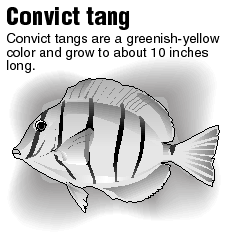Published in the Ocean Watch column, Honolulu Star-Advertiser © Susan Scott
June 29, 1998
RECENTLY, during a stroll on Kailua Beach, I came across a perfect, full-sized convict tang, or manini, lying in the sand. Thinking it might still be alive, I bent over and gently poked it. Nothing. The lovely little surgeonfish was dead.
I knelt in the sand to look over the manini, taking the opportunity to check out its scalpels. These blade-like spines, one on each side of the tail base, are where these fish get their family name of surgeonfish. However, while snorkeling around manini, I can never see these blades, even though they’re obvious in other species.

Now, even with my eyes just inches from the fish, I still couldn’t see any spines.
“It’s a manini,” a passerby said condescendingly.
The guy, no doubt, thought I was an idiot for peering at this fish so intently. Convict tangs are the most abundant surgeonfish in Hawaii.
I ignored him and continued my examination, running my fingers over the fleshy part of the fish’s tail. Not a hint of a scalpel.
I fetched my friend. “Look,” I said, once again rubbing my finger along the fish’s tail. “There aren’t any spines on this manini.” And with that, I felt a sharp pain and my finger started to bleed.
We laughed over that, then both perused the fish again. There it was, a tiny groove on each side of the fish’s tail. And inside that groove lay a perfectly camouflaged scalpel.
I connected with the scalpel the second time because I had run my finger from the back of the fish to the front, thus causing the spine to protrude slightly. It was razor sharp.
Ancient Hawaiians knew all about the manini’s sharp spines, naming them kakala, or spur of the cock.
In ancient Hawaii, manini were a popular food fish, enjoyed by royalty and commoners alike. Hawaiians preferred this fish raw, salted and not cleaned of its guts.
Convict tangs get their English name from the six black bars running down their sides. The Hawaiian name, manini, means stingy or small. I remember former Honolulu Mayor Frank Fasi often scoffing, “That’s manini,” of issues he thought trivial.
Convict tangs are common just about everywhere in Hawaii. You can see huge schools of these reef fish grazing on algae at Hanauma Bay, and I have seen enormous manini, also in large schools, on Midway’s reef.
When cruising in a group, convict tangs can easily push away lone, seaweed-eating fish. These other reef fish are quite aware of the manini’s hidden scalpels.
Spawning season for this species in Hawaii runs from December through July. Now is a good time to look for tiny manini hatchlings, which hang out near shallow coral heads, then dart into cracks when startled.
During the summer, ancient Hawaiians caught these young manini, the size of postage stamps, and dried them with salt on flat lava rocks. These fish chips stored well for future use or for trade with people who lived inland.
After connecting with the convict tang’s scalpel, I showed my cut finger to my friend, a doctor. “Forget it,” he said. “It’s manini.”